 Iskra Research
Iskra Research  Iskra Research
Iskra Research
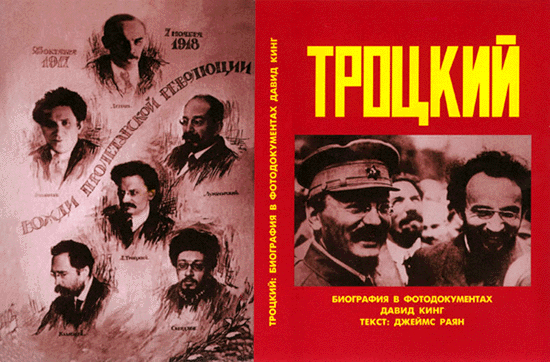
The Iskra Research Publishing House and David King proudly present, for the first time in Russian, an album entitled "Trotsky" which describes in photos and artistic illustrations the life and struggle of this leader of the October Revolution founder of the Soviet state and one of the greatest Marxists of the 20th century. This is the first illustrated publication about Leon Trotsky in the former Soviet Union.
In spite of the official opening up of archives and the uncovering of numerous secrets during the recent period, Trotsky still remains one of the least known figures of Soviet history. As before the Perestroika, his life story and ideas are still under a virtual taboo, and slanderous myths about him continue to be peddled by the Russian establishment media and academia.
The album was composed by David King, a British photographer, designer and art editor who has authored and designed other albums depicting Trotsky, the Russian revolutions of 1905 and 1917 and other pictorial works about Russia.
Here is a selection of King's works:
A visit to David King's art and photo collection
One of the latest of King's works was the publication of "The Commissar Vanishes", an illustrated album depicting the history of falsification in Stalin's Russia.
At the Berlin exhibition devoted to this book.
An interview with David King.
Trotsky as the People's Commissar for War.
Inside cover front and back
Trotsky's autobiography written in late 1917 and the account of his later years.
10
Left: Leo Bronstein (Trotsky) at the age of nine in his student uniform.
11
Trotsky at the age of 18.
12
A group of political exiles in Siberia in the autumn of 1900. First row, right: Alexandra Sokolovskaia, Trotsky's first wife. Trotsky is in the second row behind her.
14
Top left: Alexandra Sokolovskaia (standing), Trotsky on our right, Sokolovskaia's brother Gregory on our left, and G. Ziv sitting in front. These four plus a mechanic Ivan Andreyevich Mukhin in 1897 formed the leadership of the first social-democratic circle, called the "South Russian Labor Union", in the town of Nikolaiev in the south of Russia. Ziv later emigrated to the United States, and in 1921 wrote a poisonous biography about his illustrious former comrade.
15
Alexandra Sokolovskaia and her husband Leon Trotsky in exile in 1902 shortly before his escape abroad.
16
The winter of 1901-02 in Siberia. Alexandra Sokolovskaia with her and Trotsky's youngest daughter Zina on the right. Trotsky is the fourth person from the left.
18
During the 1905 Revolution Trotsky was ideologically to the left of and organizationally outside both factions of Russian Social Democracy. He was especially close to Parvus, (the pen name of Alexander Gelfand), a left wing Russian-German social-democrat, and together they put forward the idea that the Russian revolution would be led by the proletariat striving to fulfill a socialist program. This idea was later developed by Trotsky, notably in his 1907 pamphlet "Results and Prospects", and gained fame as the Theory of Permanent Revolution.
19
Trotsky in his cell in the Peter and Paul fortress. The photograph was taken by his lawyer.
20
A famous photograph of the defendants at the trial of the Petersburg Workers Soviet together with their lawyers. Trotsky was the central political figure at that famous trial and can be seen holding the case briefs.
22
Members of the Executive Committee of the Petersburg Soviet in 1905. Left to right, standing: Trotsky, then the formal chairman of the Soviet Georgi Khrustalyov-Nosar. Sitting: D.F.Sverchkov and the Bolshevik P.A.Zlydnev. Describing the relationships in the Soviet Sverchkov would later write: "The intellectual leader of the Soviet was L.D.Trotsky. The president of the Soviet, Nosar-Khrustalyov, was really a screen, for he was never able to solve a single question of principle himself. A man with an exaggerated vanity which was almost an illness with him, he came to hate L.D.Trotsky because of the very necessity of referring to him for advice and direction".
23
Natalia Sedova, Trotsky's second wife and life long companion, in 1907 during her pregnancy with their second son Sergei. Sedova met Trotsky in Paris in the fall of 1902 when he was touring European centers of Russian political emigration giving talks following his escape from exile.
24
Trotsky (hatless, second from left in front row) among other exiles on the road to Obdorsk in January 1907. Trotsky would succeed in fleeing abroad during their transport.
26
Trotsky with his daughter Zina in 1906.
27
Trotsky with his daughter Nina following his return from exile in 1917.
28
Trotsky's photo from the French-issued passport which he used to travel to the Zimmerwald anti-War conference in 1915.
29
Top left: A photo of exiles in Siberia in 1915. Top row, from left to right: Joseph Stalin and L.B.Kamenev next to him.
30
The front page of the socialist New York Jewish daily newspaper "Forverts" for January 16, 1917. In late 1916, following the machinations of the Tzarist government, Trotsky was expelled from France to Spain, and from Spain to the United States. On January 13th he arrived in New York and immediately began revolutionary anti-war agitation among the Russian, Jewish, German and other workers within the large Socialist party.
32
Trotsky arrived in Petrograd from abroad on May 4th, 1917. His travel from New York to Russia was interrupted in Canada, when the British naval authorities arrested him and his revolutionary companions and interned them in a German prisoner of war camp. Following a mass outcry in Russia he was finally released from the prison camp and on his arrival in revolutionary Petrograd Trotsky was greeted by a triumphant crowd which carried him on its shoulders from the Finland station.
The names of Lenin and Trotsky were usually coupled together during the first years of the October Revolution as the symbols of the Bolshevik Party and the proletarian victory.
36
A photo of the newly re-elected Petrograd Soviet in September of 1917. Trotsky was just released from Kerensky's prison and elected to the post of Chairman of the Petrograd Soviet, thus personifying the swing of the working class in the capital towards the Bolsheviks. Trotsky is seated in the second row, seventh from the left.
38
Top left: Trotsky's brochure "From October till Brest", a brief survey of the events of the first three months of Soviet power, which was published in early 1918.
39
A portrait of Trotsky penned by Moisey Nappelbaum in 1918.
40
A montage from an illustrated collection "October" published in 1920, which included materials about the October Revolution. Lenin and Trotsky are in the center surrounded by other leaders of the Third International and the young Soviet state. Stalin is naturally absent from this montage.
41
A poster by Viktor Deni painted during the Civil war harks back to the biblical legend with Trotsky as Saint George slaying the hydra of counterrevolution.
42
A frame from a documentary film about the Civil war shows Trotsky, the People's Commissar for War, speaking to the troops.
44
Trotsky reviews a troop of Red Cavalry.
46
During the years of the Civil war Trotsky traveled to all the far flung fronts of the conflict in a special train, equipped with a secretariat, a radio station, a telagraph, a printing press, electric power station, a library, a garage, stocks of weapons and propaganda materials, etc. This train served as the headquarters of the Red armies; it boosted morale and brought material and spiritual reinforcement wherever it went. This photo shows the arrival of Trotsky's train at the Western Front.
48
Above: A fragment of a poster showing the "Highest authority of the Soviet Republic" dated in 1920. It shows Lenin, the Chairman of the Council of Commissars, Kalinin, the Chairman of the Executive Committee of the Republic's Soviet, and Trotsky, the People's Commissar for War, Navy and Transportation.
49
A montage from the anthology "October" describing the various activities of Leon Trotsky during the Civil war.
50
A photo taken on the second anniversary of the October Revolution on Nov. 7th, 1919 in the Red Square. This photograph was last published in the Soviet Union in 1927 in a collection of photos about Lenin. Later on under Stalin the possession of this photograph was punishable by death.
52
Trotsky with his second in command Ye.M.Skliansky outside Trotsky's train.
53
A cubo-futurist painting by P.Mizakian published in the anthology about the Red Air Force.
54
Lenin is speaking at a monster meeting in the Sverdlov Square in Moscow on May 5th, 1920, devoted to repulsing the attack by Pilsudski's Poland on Soviet Ukraine and Russia. Lev Kamenev and Trotsky stand on the steps of the podium. This photo was often published in the Soviet Union, but with Trotsky and Kamenev painted out of the picture.
56
This photograph was taken at the same meeting but from another side, facing the Bolshoi Theatre. Trotsky is talking to the Red Army soldiers heading to fight against White Poland. Lenin and Kamenev stand on the steps of the podium.
58
Above: Trotsky, Lenin and Kamenev engaged in a talk following the May 5th demonstration.
59
A photograph of Trotsky taken in 1920 by the well known photographer Moisee Nappelbaum.
60
A photograph of the leaders of the Communist International taken at the Second Congress in 1920. From left to right: the Italian Socialist Party delegate Glacinto Serrati, Leon Trotsky, Alfred Rosmer from the Communist party in France, Paul Levi, the German CP leader, Gregory Zinoviev, the chairman of the Executive Committee of the CI, and Nikolai Bukharin.
61
Above: A lampoon published in the Soviet humorous journal "The Red Pepper" depicting a soccer team composed of the contemporary Soviet leaders and captained by Karl Marx. Left to right, standing: Gregory Zinoviev, Vladimir Lenin, Karl Marx, Lev Kamenev, Alexander Lozovsky and Georgy Chicherin. Seated: Karl Radek, Lev Sosnovsky, Leon Trotsky, David Riazanov and Nikolai Bukharin.
62
Trotsky with his secretary I.Impazmin and Alexei Rykov behind them at a demonstration to honor the Second Congress of the Comintern.
64
Skliansky, Trotsky and Sergei Kamenev at a parade.
65
Above: M.Kalinin, unknown, Trotsky, unknown and Lev Kamenev at a funeral for the victims of the explosion in the Moscow Party headquarters.
66
Trotsky speaking at a demonstration in the Red Square in 1920.
68
A lampoon lambasting hack artists in the magazine "The Red Pepper". Entitled "A gift to our young artists" it describes in detail how a hack artist could compose a stylized depiction of one of the Soviet leaders using a standard bald head (image #1) by adding to it various facial features: eyeglasses, moustache, beard, a pipe, a goatee, etc. One could, for example, put together a likeness of Lenin (#2), or Karl Marx (#13) or Leon Trotsky (#11), and so on.
69
One postcard out of a series published by the German CP in the early 1920's. It was entitled: "Russia: Leader of the Revolution, comrade Trotsky".
70
Leon Trotsky and a well known painter Yury Annenkov taken when Trotsky was posing for a painting.
71
Annenkov's painting of Trotsky. It was last shown at the biannual exhibition in Venice, Italy in 1924.
72
Above: Zinoviev and Trotsky in Petrograd in November 1919 during the offensive by the White general Yudenich. Trotsky had come to the city just in time to mobilize the city's defenses and defeat Yudenich.
73
Trotsky in 1921.
74
Above: A decoration by Liubov Popova for "The Earth upside down", a play written by Sergei Tretiakov and directed by Vsevolod Meyerkhold in 1923. This play was dedicated to the Red Army and to Trotsky personally. His photo is included in this montage on the left.
75
A photomontage by Alexander Rodchenko depicting Trotsky and the Red Army.
76
Trotsky surrounded by other Red Army commanders during a parade in the Red Square in 1921.
78, 79
Two cubo-futurist portraits of Trotsky by Yuri Annenkov.
80
Trotsky being filmed in his office in the Kremlin.
81
Trotsky with his close friend Khristian Rakovsky, the head of the Ukrainian Soviet republic and from 1923 the Soviet ambassador to Great Britain.
82
At a graduation parade for Red Army officers on January 10th, 1922.
84
Above: A meeting of the Council of People's Commissars in October 1922. Trotsky is the fourth person seated on the right. Behind Lenin stand Alexei Rykov and Lev Kamenev. During the later publications of this photograph under Stalin most of the participants were painted out.
85
Lenin and Stalin in Gorky in August of 1922. Stalin was appointed by the Central Committee to look after Lenin's comfort and medical care during his convalescence.
86
In January 1924 Trotsky was suffering from an inexplicable illness and took a leave to absence to rest and recover in the subtropical climate near the Black Sea. This photo was taken in Tiflis, the capital of Georgia. It was there that Trotsky found out about Lenin's death on January 20, 1924. Stalin, who was organizing the state funeral for Lenin, misinformed Trotsky about the day of the funeral thus preventing him from traveling back to Moscow to participate.
87
Above: Lenin's funeral on January 27th, 1924. The coffin is carried by (left to right): Stalin, Kamenev, T.Sapronov, I.Rudzutak, V.Molotov, M.Kalinin and N.Bukharin. Trotsky's absence from the funeral was held as an argument against him in the power struggle which had opened up.
88
Trotsky with a group of Caucasian Bolsheviks in 1924. We should be grateful to any reader who can help in identifying these persons.
90
Above: The magazine "Projector" had published this montage of the members of the Politburo in 1924. Top: Kamenev, Stalin, Trotsky. Bottom: Rykov, Bukharin and Zinoviev, M.Tomsky.
91
Trotsky at a Red Army parade in the Red Square on November 7th, 1924.
92
During the "Red Week" in 1924 dedicated to the Red Army Trotsky is saluting a parade from the podium of Lenin's Mausoleum. To the left is Kliment Voroshilov, Stalin's man in the military hierarchy. To the right is the Soviet President M.Kalinin, then Mikhail Frunze, who will soon succeed Trotsky as the War Commissar, then a German communist leader Klara Zetkin. On the upper step can be seen Semyon Budienny with his fearsome mustache.
94
Trotsky, the People's Commissar for War, surrounded by a group of graduates from a military academy.
96
This photograph depicts the funeral procession of the chief of the Cheka (the original Soviet security service), Felix Dzerzhinsky in July 1926. By this time Trotsky was again publicly opposing the majority of the Politburo and was joined by Kamenev and Zinoviev in a "Joint Opposition". Dzerzhinsky suffered a heart attack during a Party meeting where he bitterly denounced the Opposition. On this picture we can clearly see Mikhail Kalinin (in front) who cautiously and with many hesitations sided with Stalin; Trotsky, walking with a proud and fixed expression; next to him, Kamenev; on the other side of the bier, Stalin, then M.Tomsky and Nikolai Bukharin. This was Trotsky's last public appearance at which he would be officially included in the Party leadership.
98
Soviet magazine of satire, "Krokodil" dated November, 1927. The cover page is a cartoon by K.Yelisiiev, a crude attack on the Opposition. The headline says: "We are tired of this old music". The remark below, supposedly made by the music box man, Trotsky, says: "We play, and play, but no one listens!"
99
Above: Some of the leaders of the Opposition in Moscow in late 1927. Sitting to the left of Trotsky is Ivan Smirnov, once called "the Party's conscience" by Lenin. Seated to the right of Trotsky is Ivar Smilga. Standing directly behind Trotsky is B.Eltsin, and to the right of him is Man Nevelson, the husband of Trotsky's daughter Nina.
100
Above: the best known older leaders of the Opposition. Seated from left to right: Leonid Serebriakov, Karl Radek, Trotsky, Mikhail Boguslavsky and Yevgeny Preobrazhensky. Standing: Khristian Rakovsky, Y.Drobnis, A.Beloborodov and Lev Sosnovsky.
101
Another cartoon in "Krokodil" penned by Yeliseiev. The three Opposition leaders: Zinoviev, Kamenev and Trotsky are presented as broken down pensioners. Yeliseyev puts the following words in Trotsky's mouth: "We were right, the apples they threw at us were rotten, the rubber galoshes were torn to shreds. This only shows the difficult material situation of the working class, as we had said all along".
102
Trotsky in his exile in Alma Ata in Kazakhstan in 1928. At that time Alma Ata was a remote small town close to the borders with China. The railroad did not extend there and one had to travel 250 kilometers from the railhead at Frunze (Bishkek) over mountainous roads by car or by truck. Stalin thought that sending Trotsky so far away would silence the Opposition. Instead, Trotsky managed to establish extensive correspondence with dozens of political exile colonies throughout the Soviet Union and with Opposition groups abroad. He drafted and distributed two major statements criticising the policies of the Communist International, dozens of articles about the economic problems within the Soviet Union and hundreds of letters to supporters.
103
Above: Trotsky's daughter Nina. After her husband Man Nevelson was deported Nina's health sharply worsened and she died on June 9th, 1928. The news of her death was held up by Stalin's GPU and Trotsky only received Nina's last letter some months after it was written.
105
The government order decreeing Trotsky's expulsion from the Soviet Union. The official explanation for this order lay in accusing Trotsky of "counterrevolutionary activity", "provoking anti-Soviet demonstrations and preparation of armed struggle against Soviet power". Trotsky remarked in the margins of the order: "What scoundrels!"
106
Trotsky was taken by train from Alma Ata to Odessa, placed on a Soviet ship and sent to Constantinople in Turkey. This photo was taken on February 12th 1929, as Trotsky was being driven to the Soviet embassy in Constantinople for a short stay there.
109
Stalin had by now become the undisputed master of the Soviet Union. Trotsky would spend the years of his last exile defending the true Marxist doctrine from its Stalinist perversion, developing his dialectical analysis of the Soviet state and organizing the Fourth International as the Party of World Socialist Revolution.
110
Trotsky, Natalia Sedova and Lev Sedov on the island of Prinkipo in the Sea of Marmara. Trotsky was to spend four years from 1929 till 1933 on this remote island outside of Constantinople.
111
Above: Trotsky fishing with Kharalambos, a local Greek fisherman.
112
Trotsky began to write his autobiography in his Soviet exile in Alma Ata and finished it in 1929 in Turkey. Here are some of the early editions of this book in the various languages of the world.
113
Trotsky proudly shows off his catch.
114
In this photo Trotsky was visited by his wife Zina and two supposed followers, Adolf Senin (left) and Roman Weil (between Trotsky and Zina). Both men were later on discovered to have been Stalin's agents.
115
Top left: A brochure by Trotsky "Why Stalin took away my citizenship" published in the United States in Yiddish by Trotsky's supporters.
116
A photo of Trotsky delivering his lecture in Copenhagen in November of 1932.
118
This photo of Zina, Trotsky's elder daughter, was found in the archives of the american Central Intelligence Agency. Zina was suffering from consumption and depression, was living in exile away from her family in Berlin, and in January 1933 took her life.
119
Top left: Zina in Turkey in the summer of 1932 when she visited her father for the last time.
120
Oppositionists in exile. Top left is B.Eltsin. Middle row on the right is I.M.Poznansky. The rest remain unnamed.
121
Trotsky with some of his close supporters in Turkey in May of 1933. Standing next to him are Arne Swabeck and Pierre Frank. Sitting are: Jean van Heijenoort and Rudolf Klement. Klement would later be killed in Paris by Stalin's agents.
122
In the summer of 1933 the French government granted Trotsky the right to reside, clandestinely and incognito, in France, but not in Paris. On July 24, 1933 he landed secretly at a small Mediterranean village of Cassis under the watchful eyes of the French secret police.
123
Trotsky plays with his guard dogs at his residence in the village of St. Palais in the Gironde department of France.
124
Above: In May of 1935 the pressure on Trotsky to leave France increased due to the alliance between the regime of Daladier and Laval and the Soviet Union. In the spring Trotsky applied to Norway to grant him a residence permit. The Labor party had just won the elections and it was publicly anti-Stalin, although quite radical in its public program. In this photo Trotsky, his host, a socialist journalist and Parliament deputy Konrad Knudsen (in the white shirt in the foreground), Natalia (on the left) and other friends are picnicking during an expedition to see the fjords.
125
Cover of the issue of "Krokodil" in August of 1936. Stalin has staged a showcase trial of Zinoviev, Kamenev and other close comrades of Lenin and accused them of conspiring with the fascists and world reaction against the Soviet regime. This supposed anti-Soviet conspiracy brings together the fascist incendiaries, the Gestapo torturers, their bankers and Trotsky, Zinoviev and Kamenev into a joint project. The title of the caricature reads: "A common platform".
126
In the early summer of 1936 Trotsky had finished his major book analysing the Stalin regime in the USSR, "The Revolution Betrayed". In July he sent the manuscript to his publishers and translators in France and elsewhere and went on a summer vacation in the wilds of Norway. The vacation included Trotsky's favorite sport, hunting.
127
During the nightmare days of the August 1936 trial Trotsky listens in Norway to the waves of lies and slanders pouring from Radio Moscow. The "socialist" Justice minister Trygve Lie would soon remove Trotsky from his friendly residence in Knudsen's house and place him and Natalia under a house arrest. Trotsky would be prevented from communicating with the world press and his friends both in Norway and abroad, his correspondence would be stopped and censored.
128
Trotsky's official photographs upon his arrival in Mexico in January of 1937. He was then 57 years old.
130
Trotsky settled in the house of a famous Mexican painter Diego Rivera. This photograph is of Rivera's wife Frida Kahlo, herself a well known painter, and Natalia Sedova.
131
Above: Trotsky greeted by friends and journalists in Tampico, Mexico on January 9th, 1937.
132
In Mexico Trotsky at once started an urgent campaign to publicly expose the fraud of the Moscow Trials. He and his supporters issued calls to public figures on the left and within intellectual circles to set up a series of public examinations of the evidence presented by Stalin against the accused in Moscow. This culminated in a Public Trial in the United States under the chairmanship of the well known educator and philosopher John Dewey.
133
Above: A photograph of Trotsky taken by his american supporter Max Shachtman on 26th of January 1938. Trotsky is reading the book exposing the slanderous Trials in Moscow, which was published by the Dewey Commission in New York.
134
A photo of a public meeting of the Spanish Communist party in 1938. The Soviet journalist Mikhail Koltsov is on the podium.
135
Above: In March of 1938 the american Socialist Workers Party published this grim account of the fate of Lenin's general staff during the October Revolution. Out of all the members of the Central Committee during the Revolution Stalin alone remained.
136
A classic example of Stalin's falsification of history. The original photograph above shows Stalin, Lenin and Kalinin surrounded by other delegates to the Party Congress in March of 1919. Adolf Joffe stands above Lenin; F.Raskolnikov sits at his feet.
137
Another example of falsification, on an even larger scale. The original photo above showed Lenin and Maxim Gorky, and included such figures as Karl Radek, Nikolai Bukharin, Gregory Zinoviev and Mikhail Lashevich (in military uniform behind Lenin and Gorky).
138
One more example of Stalin's "artistry" in the field of photography.
Above: M.Lashevich, M.Frunze, I.N.Smirnov, A.Rykov, K.Voroshilov, J.Stalin, N.A.Skrypnik, A.S.Bubnov and Sergo Ordzhonikidze in April of 1925.
139
A caricature by the well known satirists Kukryniksy, entitled "The assassin's hygiene" and alluding to Trotsky. While accusing Trotsky of the seven deadly sins Stalin took the final step of murdering all the surviving Trotskyists in the camps in Vorkuta.
140
Lev Sedov, Trotsky's and Natalia's elder son, was a selfless and gifted supporter of his father's cause. He edited the Russian language "Bulletin of the Opposition", wrote numerous articles of Marxist analysis and, when his father was silenced by the "socialist" ministers in Norway, published an expose of the Moscow Trials entitled "The Red Book". In February of 1938 Sedov died in a clinic near Paris, the victim of a medical murder organized by Stalin's agents in France.
142
Above: The funeral of Lev Sedov in Paris. The banner belongs to Parti Ouvriere Internationalist, the French section of the Fourth International. The chubby man in dark eyeglasses on the right is Marc (Mordekhai) Zborowski, known in the movement as Etienne. He was very close to Lev Sedov and Sedov entrusted him with secret papers and documents. In February of 1928 Sedov went anonymously to a clinic to undergo an operation to remove his ailing appendix. In the course of his recovery he died. Zborowski was one of two persons (the other was Sedov's wife) who knew about the whereabouts of Sedov during his hospitalization.
143
Sergey Sedov with his nephew, Lev Sedov's son. This photo was taken in Moscow in 1934. In 1936 Sergey was arrested in Krasnoyarks, where he worked, tortured to extract an admission that his father was guilty of something, then sent to the Vorkuta camps. In Vorkuta Sergey joined with other Trotskyists in their three month long hunger strike, and eventually was shot together with all the other Trotskyist sympathizers.
144
The well known satirist Boris Yefimov (bottom center) used to flatter Trotsky when he was in power. In the 1930's Yefimov penned a large number of cartoons depicting Trotsky as a fascist hireling, an assassin, traitor and German agent.
146
Above and center: Two frescoes by Diego Rivera made in New York in 1938. The first one acclaims the Fourth International, the second one is dedicated to the Third International during the time of Lenin and Trotsky.
147
Summer of 1938; Trotsky, Rivera, Natalia Sedova, an American Trotskyist Reba Hansen, Andre Breton, Frida Kahlo and Jean van Heijenoort during an outing.
148
The son of Zina Volkova, Trotsky's daughter, has been brought from Paris by the Rosmers to live with his grandfather. From left: Trotsky, Seva, Alfred and Marguerite Rosmer and Natalia Sedova.
149
Above: A secluded house in Coyoacan near Mexico City where Trotsky had moved on May 5th, 1939. The fence and gates of this house were reinforced to defend Trotsky against Stalin's assassins.
150
Trotsky proofreads the manuscript of his unfinished biography of Stalin.
152
Stalin was hurrying his spy machine to assassinate Trotsky. A whole floor of the Lubianka HQ of the GPU was devoted to the task of spying on, sabotage against and the murder of Trotskyists around the world. A number of leading and well known supporters of Trotsky had already been assassinated: Rudolf Klement, Ignace Reiss, Sev Sedov and others.
153
The head of the Stalinist assassination squad David Alfaro Siqueiros photographed during his interrogation following his arrest in October 1940.
154
Leon Trotsky and Natalia Sedova -- friends, companions and comrades since 1902.
156
Fatally wounded Trotsky on his hospital bed on August 21st, 1940, the day after the attack.
158
Trotsky has died.
160
Trotsky's study following the attack. At that time Trotsky was working on his biography of Stalin and some of the manuscript sheets were covered in his blood.
162
Mexican police detectives are holding the murder weapon, an alpinist's icepick carried by the assasin under his coat.
163
The issue of "Labor Action", the newspaper of the Socialist Workers Party dated August 26, 1940, bids its farewell to comrade Trotsky.
164
Trotsky's assassin was a Spaniard, Ramon Mercader, a former officer in the Republican army and a member of the Spanich CP. His mother, Caridad Mercader, was a well known Stalinist and was recruited by the GPU, as was her son after her. Calling himself Jacques Mornard and pretending to be a Belgian businessman in love with one of Trotsky's American secretaries, Sylvia Ageloff, he infiltrated the household at Coyoacan pretending to be sympathetic to Trotsky.
165
The assassin was captured and beaten by Trotsky's bodyguards after Trotsky cried out for help. This photo was taken after he was arrested.
166
Natalia Sedova in the hospital surrounded by two young American friends as they wait for the doctors' verdict.
167
Above: The police staged a confrontation between Mercader and his supposed "love interest", the young american Trotskyist Sylvia Ageloff. Ageloff was in shock, crying to Mercader to tell the truth. Mercader stuck to his cover story that he attacked Trotsky for personal reasons, because of his disillusionment with Trotskyism.
168
Trotsky's funeral procession on August 22nd, 1940.
170
Natalia Trotsky during the funeral.
171
Above: Members of the Mexican section of the Fourth International stand in an honor guard at the casket of Leon Trotsky.
172
Trotsky's cremation. He once said: "Let the fire consume all that remains".
"For forty-three years of my conscious life I have remained a revolutionist; for forty-two of them I have fought under the banner of Marxism. If I had to begin all over again I would of course try to avoid this or that mistake, but the main course of my life would remain unchanged. I shall die a proletarian revolutionist, a Marxist, a dialectical materialist, and, consequently, an irreconcilable atheist. My faith in the communist future of mankind is not less ardent, indeed it is firmer today, than it was in the days of my youth.
Natasha has just come up to the window from the courtyard and opened it wider so that the air may enter more freely into my room. I can see the bright green strip of grass beneath the wall, and the clear blue sky above the wall, and sunlight everywhere. Life is beautiful. Let the future generations cleanse it of all evil, oppression, and violence and enjoy it to the full.
175
Trotsky's desk in his study.
176
His grave in Coyoacan.
For book orders please see our Price list and Order form
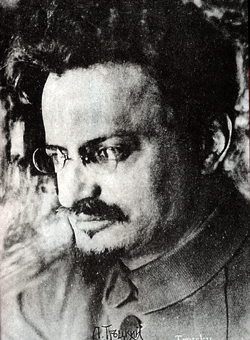
Chapter 1: The preparation.
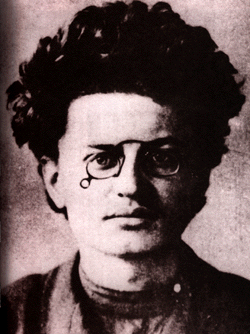 Police photos found in the archives of the Tzarist gendarmerie after the Revolution show Trotsky during his first arrest at the age of 18.
Police photos found in the archives of the Tzarist gendarmerie after the Revolution show Trotsky during his first arrest at the age of 18.
Above: his mother Anna.
Below: his father David Leontievich Bronstein, a well to do farmer in the village of Yanovka in the Kherson guberniia in the south of Ukraine.
Bottom left: This photo of political exiles in Siberia was taken in 1902. Alexandra Sokolovskaia, the woman on the left, is holding hers and Trotsky's youngest daughter Nina. Their elder daughter Zinaida is in the arms of the woman seated on the right.
Right: Trotsky photographed in exile in Siberia in 1902.
Trotsky's energy in advancing this idea brought him into the leadership of the Petersburg Council of Workers Deputies, which was the political high point of the 1905 Revolution. In early December 1905 the Council was arrested by Tzar's gendarmes and Trotsky spent the next few months in various jails and the House of Preliminary Detention in St. Petersburg.
Top, left to right: Parvus, Trotsky and Leo Deutsch, an older pioneer Russian Marxist. Trotsky explained in his autobiography that it was taken at the prison kitchen and Leo Deutsch was then planning a mass escape and urging both Parvus and Trotsky to join him.
Bottom left: Trotsky in 1902 soon after his escape from exile to the West.
Bottom right: a corridor at the notorious Peter and Paul fortress/prison. Trotsky wrote that the silence and solitude of this prison were at the time very conducive to his intellectual work.
Bottom left: police photos and fingerprints of Stalin.
Bottom right: Stalin's police photo.
At that time United States was still neutral, but tilting rapidly towards supporting the Entente against Germany. The reformist socialists on the Forverts editorial board and within the leadership of the large but amorphous Socialist Party felt political ground slipping from under their feet. Their long standing criticism of Tzarist Russia was forcing them into collision with the new requirements of American foreign policy. Trotsky was able to utilize the political bankruptcy of these pacifists and reformists exposed by these events to make rapid gains for the left wing within the Socialist party and the various East European language federations within it.
Forverts had a daily circulation of over 200,000 and Trotsky was able to place four articles in it over the next month, thereby reaching large masses of the Jewish proletariat with internationalist propaganda.
Chapter 2: The Revolution
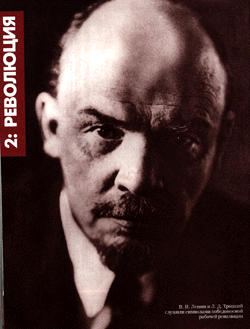
Top right: Notes of the peace talks at Brest Litovsk annotated by Trotsky.
Bottom: a meeting of the Council of People's Commissars. Trotsky is seated second from the left; to his left is Yakov Sverdlov, then Gregory Zinoviev and Mikhail Lashevich.
Below left: Trotsky and Sergey Kamenev, a former Tzarist general who became one of the commanders in the red Army.
Below right: A meeting at HQ. Seated from left to right: Bela Kun, Alfred Rosmer (two leaders of the Communist International), Trotsky, M.V.Frunze and S.I.Gusev (two leaders of the Red Army).
Below: Another mass demonstration in Moscow in 1920. The posters carried by demonstrators show the images of Lenin, Volodarsky, a Bolshevik leader assassinated by the SRs in 1918, Karl Marx, Karl Liebknect, a German communist leader murdered by reactionary soldiers in January of 1919, and Leon Trotsky.
Below left: Trotsky surrounded by some of the Red commanders personally serving under him. We know only some of their names: Butov, Glazman, Sermuks, Poznansky and Nechayev. Later they were driven to suicide or killed in the Purges.
Bottom right: Trotsky speaking to one of the many child volunteers adopted by the various Red Army units.
Below: Trotsky speaking at a demonstration near the wall of the Kremlin.
Below: Lenin and Trotsky posing among those delegates to the 10th Party Congress in March 1921 who volunteered to be sent to Kronstadt to suppress the rising by the anarchists.
Below: Trotsky with his two young sons at a demonstration in Moscow in 1920.
Chapter 3: The fall.
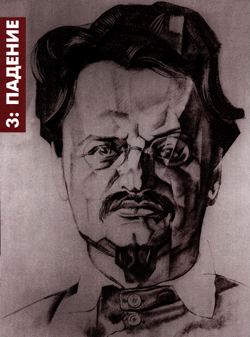
Below: Alfred and Marguerite Rosmer visited Natalia Sedova and Trotsky, and their two sons Liova and Sergei in the summer of 1923.
Below left: Trotsky with his doctor.
Below right: Trotsky standing on Lenin's Mausoleum.
Below: Trotsky in the center standing and Natalia Sedova sitting with a group of people at a Caucasian health resort in 1924.
Below: Some of the leaders of the Opposition. In the front row are Trotsky, Kamenev and Zinoviev.
Below: Trotsky and his long time friend Adolf Joffe photographed in an automobile belonging to the Central Committee on Concessions, where both were serving at this time. Joffe was a member of the Central Committee from 1917 till 1919 and served as the Soviet ambassador to Germany, China, Japan and elsewhere. He was also a major supporter of the Left Opposition. For their Opposition activity both Trotsky and Joffe were shuffled out of their important Party and State posts and placed on this Committee, which dealt with economic and foreign trade affairs. In November of 1927 Joffe would commit suicide in protest against the expulsion of Trotsky and Znoviev from the Party.
Middle: A group of exiled Left Oppositionists in Siberia celebrating the 11th anniversary of the Revolution. The banner on the left demands to reverse the current right wing course of the party and "to turn the fire against the NEPman, the bureaucrat and the Kulak". The central banner carries pictures of Lenin and Trotsky.
Bottom: Trotsky's youngest son Sergey Sedov. Sergey was apolitical, a talented engineer. He would also be exiled and killed in 1937.
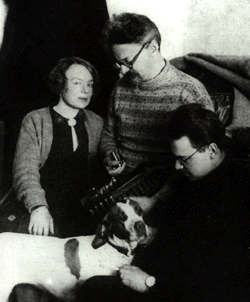 104
Trotsky with his wife Natalia Sedova and their elder son Lev in their house in Alma Ata shortly after their arrival in late January of 1928.
104
Trotsky with his wife Natalia Sedova and their elder son Lev in their house in Alma Ata shortly after their arrival in late January of 1928.
Chapter 4: Exile
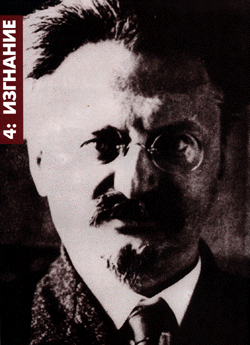
Middle: At his desk with a copy of the American Trotskyist newspaper.
Bottom: The house where he lived on Khamladji street.
Below: A caricature against Trotsky published by Viktor Deni in the newspaper Pravda. Deni condemns Trotsky for selling his articles to the British newspaper "The Daily Express".
Top right: Trotsky's brochure "The only way" describing his program of United Front struggle against fascism published in September 1932 by his supporters in Germany.
Bottom: In November of 1932 Trotsky was granted a temporary permit to come to Copenhagen in Denmark to deliver a lecture in front of radical Danish students on the 15th anniversary of the October Revolution. On his way there and back he was under constant supervision by the various police departments. This photo was taken at the Gare du Nord in Paris and Trotsky hid his face from the nosy reporter.
Top right: Khristian Rakovsky photographed in his exile in Astrakhan.
Bottom: Trotsky surrounded by some of his young supporters in France in August of 1933.
Bottom: A special printing of miniaturized Russian language Opposition journal, "Bulletin of the Opposition". It was printed this way on very thin paper to enable copies to be smuggled into the Soviet Union. Victor Serge described such smuggling and other oppositional activity in Stalin's Gulag in his novel "Midnight in the Century".
Top left: After shaving off his distinctive goatee Trotsky tried to alter his appearance to enable him to reside anonymously in the French provinces.
Top right: Under the pressure both from the French fascists and the "communists" the French government tried in April of 1934 to expel Trotsky to another country, but failed because none would accept the "dangerous subversive". It then issued him a false passport and permitted him again to reside clandestinely in the provinces.
Bottom: In December of 1934 Stalin organized an elaborate provocation to incite an unstable young Party member Nikolaiev to make an attempt on the life of Stalin's emissary in Leningrad, Sergey Kirov. The provocation misfired, or rather, Nikolaiev's revolver fired too soon, and Kirov was killed. Stalin tried to tie the Trotskyist opposition into the supposed terrorist plot, but did not succeed. He did force Zinoviev and Kamenev to confess to "moral responsibility" for this assassination in a trial in January of 1935.
This pamphlet by Trotsky scrupulously examines the available evidence around the Kirov assassination and accuses Stalin of provocation designed to open the way for mass persecutions and purges of all political opposition.
Below left: M.D.Berman from the OGPU, V.M.Molotov, Joseph Stalin, N.I.Yezhov and K.Y.Voroshilov are on a tour of inspection during the excavation of the Volga-Don Canal.
Below right: The first American edition of Lenin's Testament with Trotsky's explanation.
The nightmare of the Purges begins
Meanwhile a band of Norwegian fascists broke into Knudsen's house, where Trotsky and Natalia resided, and tried to steal some documents. This incident would soon serve the "socialist" Norwegian government as a pretext to intern Trotsky.
In sum, under pressure from Stalin the Norwegian government would attempt to prevent Trotsky from exposing the slanderous Moscow Trials. Finally, in December of 1936, after the Mexican government announced its granting of a residence permit to Trotsky, he would be placed on a Norwegian steamer and expelled to Mexico.
Chapter 5: Mexico
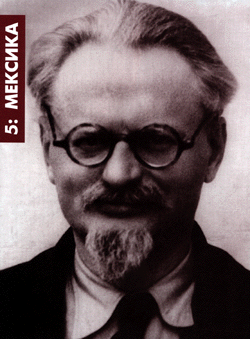
Bottom left: A pre-arrival haircut on the deck of the Norwegian steamer.
Bottom right: Trotsky and Diego Rivera, in whose house he would live.
This photo shows Trotsky's bench during a week-long taking of depositions in April of 1937 in Mexico during the preliminary hearings. From left to right: Jean van Heijenoort, Trotsky's american lawyer Albert Goldman, Trotsky, Natalia Sedova and a Czech supporter Jan Fraenkel.
Below: The front page of a special newspaper, published in April of 1937 by the Committee to Defend Leon Trotsky, announcing the start of the investigation.
Below: The head of the secret police Yezhov and Stalin during the celebration of the 20th anniversary of Cheka on November 20th, 1937.
Below: This is how this photo was cropped in Stalin's times. Only Stalin, Lenin and Kalinin remained.
Below left: In 1939 this photo was cropped and retouched to leave only Lenin and Gorky.
Below right: In a 1986 publication Lashevich and a few others were restored to history.
Below: When this was published in 1949 in a photo album about Stalin, only Frunze, Voroshilov, Stalin and Ordzhonikidze were left in the picture.
These pamphlets by Leon Trotsky were published by his supporters in the US and China.
It was discovered later, during the anti-communist trials in the United States, that Marc Zborowski was Stalin's agent within the Russian Opposition abroad and within the Paris Trotskyist groups. Regrettably, it was Marc Zborowski who after Sedov's death was entrusted with continuing the publication of the Russian "Bulletin of the Opposition".
Below left: Sedov with his wife Jeanne Martin.
Below center: Marc Zborowski during his testimony in 1958 before a congressional commission investigating antiamerican activities.
Below right: Lev Sedov with his father during a happier moment in August of 1933 in St. Palais.
Below: in 1938 Andre Breton, Diego Rivera and Leon Trotsky discuss the publication of the "Manifesto for a free revolutionary art".
Below: Trotsky feeds rabbits in the yard of his house.
Inset: A well known photo of Stalin greeting Hitler's emissary von Ribbentropp in August of 1939 as they prepared to conclude the Stalin-Hitler Pact.
In May of 1940 a band of Mexican Stalinists led by the well known radical painter and member of the Central Committee of the Mexican CP David Alfaro Siqueiros organized an armed raid on Trotsky's house in Coyoacan. Somehow they persuaded the guard on duty that night, a young american Robert Sheldon Harte, to open the gates, they shot up Trotsky's bedroom and wounded his grandson Seva Volkov asleep in the next room. Trotsky and his wife survived by crawling down on the floor of their bedroom until help arrived.
The assassins escaped with Harte and his body was found later.
Left: Trotsky explaining the details of the attack the next day. The Stalinist press accused Trotsky of stagind a make believe attack to attract publicity and he had to explain in great detail what had really happened.
Top right: a police photo of Harte's head when his body was found badly decomposed in a lime pit.
Center right: A profile photo of Harte.
Bottom right: the inscription placed on Harte's headstone.
Chapter 6: The murder
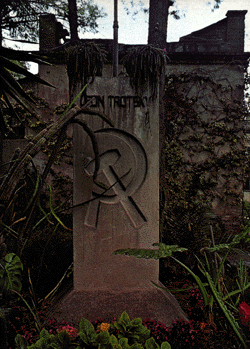
Top left: Police card bearing the fingerprints and the photographs of the man who called himself Jacques Mornard.
Bottom left: Caridad and Ramon Mercader.
Top right: Mercader in prison in 1950. He was well taken care of and ate pretty well.
Bottom left: Mercader boarding a ship bound for Cuba in 1960. Upon his release from prison in 1960 Mercader traveled to Cuba, then to Czechoslovakia, and from there to Moscow. He settled in Moscow, was accorded all sorts of privileges, awarded the medal of Hero of the Soviet Union, and at his death was buried in an exclusive cemetery among other "friends of the USSR".
Center and bottom photographs: Sylvia Ageloff in a state of shock and collapse after discovering how she had been used by her suitor in a plot to murder Trotsky.
Bottom left: Trotsky in an open casket.
Bottom right: Natalia Sedova in 1941 in Mexico showing to her friends a newspaper headline announcing a Stalinist death threat against her. Natalia Sedova died much later in 1962 in Paris.
From Trotsky's Testament:
L.Trotsky
For more information about Iskra Research